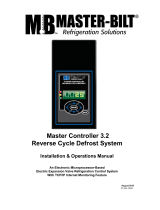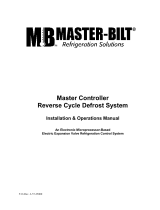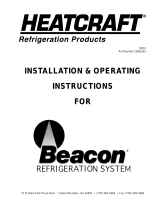Page is loading ...

1
Advanced Master Controller 3.2 Setting Quick Reference Guide
(MB P/N: 19-14282 with Pressure Transducer. Revised December 2017)
NOTE: If you are replacing an Advanced Master Controller 2.0 control board in a walk-in cooler or freezer
with either air, electric or reverse cycle defrost, please see the list of typical set points on page 4. The
chart shows the correct settings to follow for each defrost type.
Setting the Advanced Master Controller 3.2 by On-Board Pushbuttons: Up arrow,
Down arrow, Left arrow, Right arrow, Enter, Back.
CHANGING ALL SET POINTS
Press the Left arrow or Right arrow until the display reads ‘STPT’. Press Enter. If the display shows ‘PSWD’ you need to
enter the password. Press Enter. Use the Up and Down arrows to increment or decrement the blinking digit. Use the Right
and Left arrows to move the blinking digit to the right or left. Enter the password ‘0002’. Press and hold the Enter button
until the display shows one of the set points (about 3 seconds). Press the Enter and Back to toggle between the set point
name and the set point value. Press the Up or Down arrows to scroll through the list of set points. To change a set point,
have the display show the value of the set point. Hold Enter until one of the digits starts blinking (about 3 seconds). Use the
Up and Down arrows to increment and decrement the digit. Use the Right and Left arrows to move the blinking digit right or
left. When the new value is displayed, press and hold Enter until all digits stop blinking (about 3 seconds). Press Back, 3
times at any time to leave set point mode
CLEARING AN ALARM
Press the Left arrow or Right arrow until the display reads ‘MNMD’. Press Enter. If the display shows ‘PSWD’ you need to
enter the password. Press Enter. Use the Up and Down arrows to increment or decrement the blinking digit. Use the Right
and Left arrows to move the blinking digit to the right or left. Enter the password ‘0002’. Press and hold the Enter button
until the display shows one of the manual modes (about 3 seconds). Press the Up or Down arrows to scroll through the list of
manual modes until the display shows ‘ALST’. Press Enter. Display shows ‘CLAL’. Press and hold Enter until the display
changes (about 3 seconds). Press Back, 3 times at any time to leave manual mode.
MANUAL DEFROST
Press the Left arrow or Right arrow until the display reads ‘MNMD’. Press Enter. If the display shows ‘PSWD’ you need to
enter the password. Press Enter. Use the Up and Down arrows to increment or decrement the blinking digit. Use the Right
and Left arrows to move the blinking digit to the right or left. Enter the password ‘0002’. Press and hold the Enter button
until the display shows one of the manual modes (about 3 seconds). Press the Up or Down arrows to scroll through the list of
manual modes until the display shows ‘MCTL’. Press Enter. Display shows current system mode (REFR, OFF, DEFR,
DRAN, FNDL). Press and hold Enter until the display changes to next system mode (about 3 seconds). System needs to be
in REFR or OFF mode to go to DEFR or defrost mode. Press Back, 3 times at any time to leave manual mode.
STATUS, DEFAULT AND READING DISPLAY
The status and the digital data can be displayed on the onboard display. Below is a list of the parameters of the operational
status.
Onboard
Display Description
STUP Indicates the status of Start Up Mode
CKFN Check fan working status. The fans run than stop during start-up mode
CKP1 Check pressure transducer
OKP1 Indicates the pressure transducer is working as it should
CKT1 Check sensor TS1, sensor the evaporator suction outlet/fan cut-in temperature sensor
OKT1 Indicates the TS1 is working as it should
CKT2 Check sensor TS2, the refrigerated room temperature
OKT2 Indicates the TS2 is working
CKT3 Check sensor TS3, the evaporator inlet/defrost termination temperature sensor

2
OKT3 Indicates the TS3 is working
CKFH Indicates all sensors are OK
FNDL Indicates FAN DELAY MODE
FDTP Actual TS1 value in FAN DELAY
COOL Indicates COOL MODE
OFF Indicates OFF MODE
PMDN Indicates PUMPDOWN MODE before an electric defrost
DEFR Indicates DEFROST MODE
DRAN Indicates COIL DRAIN MODE
DFTP Inlet sensor TS3 value in DEFROST MODE
CHANGING PARAMETERS
A list of the parameters that can be displayed and/or changed is shown below when access to the default settings is needed.
This access is usually done by a trained technician.
Onboard
Display Description
RMTP Refrigerated room temperature from TS3 (-60
o
F to +150
o
F), displayed value
VALV Percentage the valve is open (0 to 99%)
SUPH Actual superheat in COOL MODE (TOUT-TSAT)
TSAT Saturated suction temperature calculated from suction pressure PRES
TSUC Evaporator suction outlet temperature from TS1
TCOI Temperature read from the evaporator defrost termination sensor TS3
PRES Suction pressure read from the pressure transducer (-14.6 to 135.5 PSIG)
Note: the above parameters are status variables that allow you to check the system operations;
the below parameters are set points that can be changed to fit the applications
MEVM Multi Evaporator Mode options are synchronous mode or alternating mode
ALTN Indicates controller is in alternating mode after bonding
SYNC Indicates controller is in synchronous mode after bonding
Note: If no bonding is made, the controller works as stand alone
SHSP Superheat set point (5 to 30
o
F).
RMSP Room temperature set point or cut-out (-50 to +90
o
F)
MXDT Maximum defrost duration (0 to 90 minutes)
DTSP Defrost termination temperature (35 to 90
o
F)
PMDN Pump down timeout duration (0 to 5 minutes)
DRAN Drip time duration (0 to 15 minutes)
DFPD Number of defrosts per day (0 to 8). When DFPD = 0, demand defrost, when DFPD = 1 to 8,
the controller uses scheduled defrost
HITA High temperature alarm offset from room set point RMSP (0 to +99
o
F)
HIDL Temperature alarm delay (0 to 120 minutes)
LOTA Low temperature alarm offset from room set point RMSP (0 to +20
o
F)
MOTM Minimum time the valve is close (0 to 15 minutes)
MRTM Minimum time the valve is open (0 to 15 minutes)
ADIF Cut-in temperature differential (0 to +25
o
F)
MOP Maximum suction pressure set point (-10 to 135 PSIG)
MNPR Minimum pressure set point (-14 to 100 PSIG)
INTV When in demand defrost and temperature set point is below 35°F, maximum amount of time between
defrosts (480 to 4320 minutes)
DFMD Defrost type (electric, air or reverse cycle, ELEC, AIRD and HGDF)
REFT Refrigerant type, R404 (404A) or R22 (R22)
ALSP If in alternating mode, number of degrees above cut-in (cut-out + ALSP) set point to
override and both controllers to go into cool mode (0-25
o
F)

3
ALARM DISPLAY
Any alarm will cause relay #3 to switch. All alarms have a distinct display on the controller. The red LED will be on for a
pressure sensor alarm or TS1, suction temperature sensor alarm. The amber LED will be on for all other alarms. Multiple
alarms can exist. There is a priority as to which alarm will be displayed before another.
Onboard
Display Description PRIORITY
NOAL Displays when there are no alarms. The onboard display will display
status and temperature readings
PRSA Pressure transducer 1
STSA Evaporator outlet temperature sensor TS1 alarm 2
ATSA Room temperature sensor TS2 alarm 3
LOSH Low superheat alarm 4
HITA High room temperature alarm 5
LOTA Low room temperature alarm 6
CTSA Defrost termination sensor TS3 alarm 7
LPRA Low pressure alarm 8
COMA Communication alarm 9
TROUBLESHOOTING GUIDE
Trouble, Alarm Codes
Causes
Corrective Actions
Pressure transducer alarm
PRSA
• Bad transducer
• Out of range
• Loose wire
•
Wrong hook-up
• Replace the pressure transducer
• Turn off power for a few seconds, turn back on
• Toghten the connections
•
Wire correctly
Outlet sensor TS2 fails
SCSA
• Mechanical damage
• Connection wire loose
• Overheated
• Out of range
• Replace the sensor
• Tighten the connection wires
• When brazing suction line, take out the sensor
• Install the sensor after brazing
Room sensor TS3 fails
ATSA
• Mechanical damage
• Connection wire loose
• Overheated
• Out of range
• Tighten the connection wires on the controller
terminal
• The room sensor can be replaced by surface sensor
Low superheat
LOSH
• Superheat setting too low
• Wrong locations of TS2
• Sensors may be loose
• Uneven feeding of coil circuits
• Overcharge of refrigerant
Defective electric expansion valve (EEV)
• Compressor stops
• Change to correct set point
• Make sure the distributor is feeding each circuit
evenly
• Insulate the sensors with foam tape
• Use correct refrigerant charge
• Check EEV wiring
• Replace defective EEV
• Check compressor
High room temperature
HITA
• Insufficient refrigeration
• Heat load too large
• Compressor fails or high pressure cuts out
• Evaporator fans may not run
• Door open for too long
• Coil iced-up
• Check system design to select a sufficient system
• Replace failed compressor
• Fix the evaporator fans
• Keep the cold room door closed during refrigeration
• Check possible air leak through the walls of cold
room
Low room temperature
LOTA
• Inproper low temp setpoint
• Over designed system
• Change low temp set point
• Re-select the system
Defrost termination sensor TS1 fails
CTSA
• Mechanical damage
• Loose connection wire
• Overheated
• Out of range
• Tighten the connection wires on the controller
terminal
• Let the sensor cool down to application temperature
range: –50
o
F to +103
o
F
• Replace failed sensor
Low pressure alarm
LPAL
• Refrigerant leak
•
Bad transducer
• Fix leak
•
Replace pressure transducer
Communication
COMA
• Loose RJ-45 coonection
• Failed communication port
• Replace connector
• Change a new controller board

4
Temperature Sensor The resistance of the temperature sensor at 32
o
F ice water is 5,122 ohms.
Pressure Transducer RED --- +5VC, Green --- Signal Voltage, Black --- Ground; Compare gauge pressure and the
“PRES” suction pressure on-board reading to make sure they both read the same (PSIG)
Electric Expansion Valve
1) The resistance between the black and white leads should be around 90 ohms. The resistance between
the black and red leads should be an open.
2) The resistance between the red and green leads should be around 90 ohms. The resistance
between the white and green leads should be an open.
3) The resistance between each lead and the brass housing of the valve should be an open
4) Read the AC, not DC, voltage across the black and white leads while the valve is
moving. The AC voltage should be 11 to 13 VAC. The voltage will be close to 0 VAC when the valve
is not moving.
5) Repeat step 4 across the red and green leads
TYPICAL SET POINTS FOR CONTROLLER
Air/Electric Defrost
Reversing Cycle Defrost
Low Temp
High Temp
Low Temp
High Temp
RMSP
-10
35
-10
35
ADIF
5
3
5
3
MRTM
2
2
2
2
MOTM
2
2
2
2
MNPR
0
0
0
0
MOP
55
80
55
80
DFPD
0
0
0
0
DFMD
ELEC
ELEC
RCD
RCD
INTV
720
1440
720
1440
DTSP
75
45
60
60
MXDT
35
35
20
20
DRAN
2
2
5
2
MEVM
ALTN
ALTN
ALTN
ALTN
ALSP
5
5
5
5
HITA
25
15
25
15
HITD
59
59
59
59
LOTA
10
15
10
15
REFR
449A
449A
449A
449A
SHSP
10
10
10
10
Please check with factory for actual set points on individual controllers.
For complete information, please refer to the Master Controller 3.2 Installation & Operations Manual or contact:
Master-Bilt Products
Technical Service Department
Highway 15 North
New Albany, MS 38652
Phone: 800-684-8988
Fax: 800-882-7629
Email: service@master-bilt.com
/











